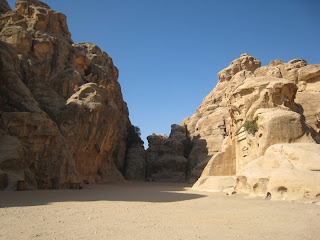Again, my dad's comments are in blue.
Little Petra is located a short distance from the town of Wadi Musa, a suburb actually. Only when measured against Petra proper does one think “little.” It is within the same canyon or geological bowl, and it includes outstanding natural rock features as well as tombs and other sites carved from the stone, only this stone is more white than the heavy rose color of Petra.
Scholars speculate that Little Petra served a more commercial function, although there are a significant number of tombs, cisterns, aqueducts as well as biclinia and triclinia. The facade at the entry is both magnificent and simple, and as one enters more deeply into Little Petra (Al-Beidha), the walls of the canyon close ever-so tightly so that not even a camel can pass; this entry is known as Siq al-Barid.. These narrow crevices then open again into natural courtyards -- there are three of them.
The walk through this ancient city is breathtaking and helps remind us again of the capabilities and sense of community of these ancient peoples. The second courtyard, for example, seems to have been a place for feasting, for there are numerous biclinia or triclinia (dining areas). (See a triclinium below.)
One of the rooms, for example, contains the only known example of Nabatean painting, a frescoed ceiling. To preserve this fresco it was protected by iron bars.
Again the various niches, caves and natural formations are connected by stairways carved in the stone throughout Little Petra.
Here, we are climbing to what appears to be another place of sacrifice, located at a high point in the area. Below, my dad stands on the spot and surveys the city below.
The visit to Little Petra only confirmed the strong sense of community experienced by the Nabateans, as well as provided more evidence of their ingenuity and energy. They were an important people in an important place, and a better understanding of their culture helps us understand the peoples of ancient Middle East.
As we left the Valley of Moses (Wadi = valley, Musa = Moses) we stopped to appreciate a panoramic view of the area. At the highest point, in the upper left of the photo, is Jabal Haroun or Aaron’s Mountain, the Mount Hor of the Old Testament, and it is believed to be the site of Aaron’s Tomb. A careful look will reveal a small, white area where the monument reflects the light of the bright sun. In the valley below you see nothing to reveal what is there. Petra, the red-rose city, was also a hidden city.
Thus the entire city was invisible to the many traders who passed on this important ancient route from Egypt to Syria. Scholars speculate that the Nabateans staged raids on the caravans from this hidden city.
Before we leave Petra and Little Petra, I just wanted to note an interesting theory regarding St. Paul's three-year period in "Arabia" after his conversion. According to this theory, which is laid out well and concisely explained here, St. Paul spent at least some of this time evangelizing the people of Arabia, which was not some empty wasteland of desert, but included the very advanced people of the Nabatean Kingdom and its capital, Petra. The Nabatean Kingdom also included Jews and synagogues. This would then help explain why the powerful Nabatean king, Aretas IV, goes to the trouble of trying to have St. Paul killed in Damascus, as St. Paul himself tell us in 2Cor 11:32-33. To me, this theory is very plausible.
For more photos from Little Petra, click here.















No comments:
Post a Comment